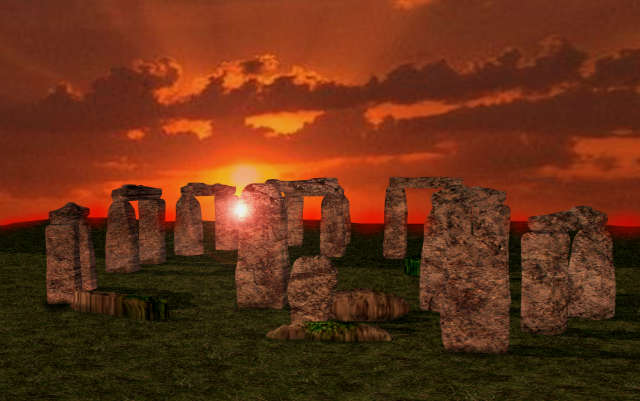About 5,000 to 4,000 years ago, the genetic profile changes radically, suggesting that some mysterious event led to a huge turnover in the population that made up Europe.
An Australian team found the unexplained change while analyzing several skeletons unearthed in central Europe that were up to 7,500 years old.
They say the rapid expansion of the Bell Beaker culture, which is believed to have been instrumental in building the monoliths at Stonehenge, could hold the key.
Researchers say the rapid expansion of the Bell Beaker culture, which is believed to have been instrumental in building the monoliths at Stonehedge, could hold the key to why the genetic lineage of Europe mysteriously transformed about 4000 years ago
BEAKER FOLK
Beaker folk lived about 4,500 years ago in the temperate zones of Europe and received their name from their distinctive bell-shaped beakers, decorated in horizontal zones by finely toothed stamps.
A warlike race, they were primarily bowmen and their extensive search for copper and gold greatly accelerated the spread of bronze metallurgy in Europe. Believed top be originally from Spain, the Beaker folk soon spread into central and western Europe in their search for metals.
In central Europe they came into contact with the Battle-Ax culture and gradually intermixed and later spread from central Europe to eastern England, where it may have been responsible for erecting some of the megaliths at Stonehenge.
‘What is intriguing is that the genetic markers of this first pan-European culture, which was clearly very successful, were then suddenly replaced around 4,500 years ago, and we don’t know why,’ study co-author Alan Cooper of the University of Adelaide Australian Center for Ancient DNA said.
‘Something major happened, and the hunt is now on to find out what that was.’
More…
The breathtaking video that shows three years of activity on the sun in just three MINUTES
The Romanian Romeo and Juliet: Mystery of the young couple buried holding hands in courtyard of monastery
Ancient DNA recovered from a series of skeletons in central Germany up to 7500 years old has been used to reconstruct the first detailed genetic history of modern Europe.
The study, published today in Nature Communications, reveals a dramatic series of events including major migrations from both Western Europe and Eurasia, and signs of an unexplained genetic turnover about 4000-5000 years ago.
The research was performed at the University of Adelaide’s Australian Centre for Ancient DNA.
Researchers used DNA extracted from bone and teeth samples from prehistoric human skeletons to sequence a group of maternal genetic lineages that are now carried by up to 45% of Europeans.
The international team also included the University of Mainz in Germany and the National Geographic Society’s Genographic Project.
‘This is the first high-resolution genetic record of these lineages through time, and it is fascinating that we can directly observe both human DNA evolving in ‘real-time’, and the dramatic population changes that have taken place in Europe,’ says joint lead author Dr Wolfgang Haak of ACAD.
‘We can follow over 4000 years of prehistory, from the earliest farmers through the early Bronze Age to modern times.
‘The record of this maternally inherited genetic group, called Haplogroup H, shows that the first farmers in Central Europe resulted from a wholesale cultural and genetic input via migration, beginning in Turkey and the Near East where farming originated and arriving in Germany around 7500 years ago,’ says joint lead author Dr Paul Brotherton, formerly at ACAD and now at the University of Huddersfield, UK.
The team developed new advances in molecular biology to sequence entire mitochondrial genomes from the ancient skeletons.
Beaker folk, lived about 4,500 years ago in the temperate zones of Europe and received their name from their distinctive bell-shaped beakers, decorated in horizontal zones by finely toothed stamps
This is the first ancient population study using a large number of mitochondrial genomes.
‘We have established that the genetic foundations for modern Europe were only established in the Mid-Neolithic, after this major genetic transition around 4000 years ago,’ says Dr Haak.
‘This genetic diversity was then modified further by a series of incoming and expanding cultures from Iberia and Eastern Europe through the Late Neolithic.
Read more: DailyMail
Best Regards
TBU NEWS



